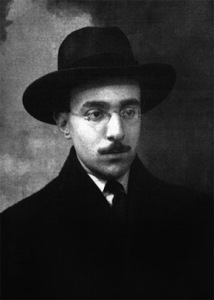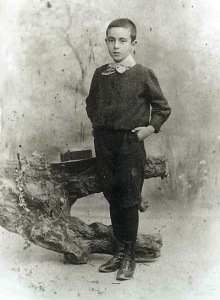Disquiet revisited
by Margaret Jull Costa
“In a time which celebrates fame, success, stupidity, convenience and noise, here is the perfect antidote.” John Lanchester
Fernando Pessoa’s life divides neatly into three periods. In a letter to the British Journal of Astrology dated 8 February 1918, he wrote that there were only two dates he remembered with absolute precision: 13 July 1893, the date of his father’s death from TB when Pessoa was only five; and 30 December 1895, the day his mother remarried, which meant that, shortly afterwards, the family moved to Durban, where his new stepfather had been appointed Portuguese Consul. In that same letter, he mentions a third date too: 20 August 1905, the day he left South Africa and returned to Lisbon for good.
That first brief period was marked by two losses: the deaths of his father and of a younger brother. And perhaps a third loss too, that of his beloved Lisbon. During the second period, despite knowing only Portuguese when he arrived in Durban, Pessoa rapidly became fluent in English and in French.
He was clearly not the average student. When asked years later, a fellow pupil described Pessoa as: “A little fellow with a big head. He was brilliantly clever but quite mad.” In 1902, just six years after arriving in Durban, he won first prize for an essay on the British historian Thomas Babington Macaulay. Indeed, he appeared to spend all his spare time reading or writing, and had already begun creating the fictional alter egos, or as he later described them, heteronyms, for which he is now so famous, writing stories and poems under such names as Chevalier de Pas, David Merrick, Charles Robert Anon, Horace James Faber, Alexander Search and more. In their recent book Eu sou uma antologia (I am an anthology), Jerónimo Pizarro and Patricio Ferrari list 136 heteronyms, giving biographies and examples of each heteronym’s work. In 1928, Pessoa wrote of the heteronyms: “They are beings with a sort-of-life-of-their-own, with feelings I do not have, and opinions I do not accept. While their writings are not mine, they do also happen to be mine.”
The third period of Pessoa’s life began when, at the age of seventeen, he returned alone to Lisbon and never went back to South Africa. He returned ostensibly to go to university. For various reasons, though – among them, ill health and a student strike – he abandoned his studies in 1907 and became a regular visitor to the National Library, where he resumed his regime of voracious reading – philosophy, sociology, history and, in particular, Portuguese literature. He lived initially with his aunts and, later, from 1909 onwards, in rented rooms. In 1907, his grandmother left him a small inheritance and in 1909 he used that money to buy a printing press for the publishing house, Empreza Íbis, which he set up a few months later. Empreza Íbis closed in 1910, having published not a single book. From 1912 onwards, Pessoa began contributing essays to various journals; from 1915, with the creation of the literary magazine Orpheu, which he co-founded with a group of artists and poets including Almada Negreiros and Mário de Sá-Carneiro, he became part of Lisbon’s literary avant-garde and was involved in various ephemeral literary movements such as Intersectionism and Sensationism. Alongside his day job as freelance commercial translator between English and French, he also wrote for numerous journals and newspapers, translated Nathaniel Hawthorne’s The Scarlet Letter, short stories by O. Henry and poems by Edgar Allan Poe, as well as continuing to write voluminously in all genres. Very little of his own poetry or prose was published in his lifetime: just one slender volume of poems in Portuguese, Mensagem (Message), and four chapbooks of English poetry. When he died in 1935, at the age of forty-seven, he left behind the famous trunks (there are at least two) stuffed with writings – nearly 30,000 pieces of paper – and only then, thanks to his friends and to the many scholars who have since spent years excavating that archive, did he come to be recognised as the prolific genius he was.
Pessoa gave all his heteronyms complex biographies, and they all had their own distinctive styles and philosophies. They sometimes interacted, even criticising or translating each other’s work.”
Pessoa lived to write, typing or scribbling on anything that came to hand – scraps of paper, envelopes, leaflets, advertising flyers, the backs of business letters, etc. He also wrote in almost every genre – poetry, prose, drama, philosophy, criticism, political theory – as well as developing a deep interest in occultism, theosophy, and astrology. He drew up horoscopes not only for himself and his friends, but also for many dead writers and historical figures, among them Shakespeare, Oscar Wilde and Robespierre, as well as for his heteronyms, a term he chose over ‘pseudonym’ because it more accurately described their stylistic and intellectual independence from him, their creator, and from each other – for he gave them all complex biographies and they all had their own distinctive styles and philosophies. They sometimes interacted, even criticising or translating each other’s work. Some of Pessoa’s fictitious writers were mere sketches, some wrote in English and French, but his three main poetic heteronyms – Alberto Caeiro*, Ricardo Reis, Álvaro de Campos – wrote only in Portuguese and each produced a very solid body of work.
Yet even his masterwork The Book of Disquiet had more than one author and was never completed, never put into any order, remaining always fragmentary. Its first ‘author’ was Vicente Guedes, who wrote semi-symbolist prose pieces for inclusion in something that, as early as 1913, Pessoa was already calling The Book of Disquiet. These texts often described particular states of mind or imaginary landscapes or offered advice to would-be dreamers or even unhappily married women (a subject about which the apparently celibate Pessoa knew nothing at all at first hand) or those who, like him, had lost their religious faith. Around 1920, however, the book seemed to lose its way, and Pessoa forgot about Guedes and the Book of Disquiet. Then, in 1929, the book took a different direction with a different ‘author’, Bernardo Soares, a humble accounts clerk working in an office in downtown Lisbon and spending his leisure hours writing this “autobiography of someone who never existed”. Soares was described by Pessoa as only a “semi-heteronym”, because, “although his personality is not mine, it is not different from, but rather a simple mutilation of my personality. It’s me minus reason and affectivity.”
Pessoa clearly felt that Soares was a more suitable author and even drew up a plan of what to do with all those fragments:
The organisation of the book should be based on as rigorous a selection as possible of the various existing texts, adapting any older ones that are untrue to the psychology of Bernardo Soares… Apart from that, there needs to be a general revision of style, without it losing the personal tone or the drifting, disconnected logic that characterises it.
Pessoa never undertook this rigorous process of selection and adaptation. The ‘book’ thus remained forever a work in progress. Indeed, although some fragments were published in magazines during Pessoa’s lifetime, it did not appear in book form in Portuguese until 1982, forty-seven years after Pessoa’s death. This was thanks to Maria Aliete Galhoz, Teresa Sobral Cunha and Jacinto do Prado Coelho, who deciphered Pessoa’s near-illegible writing and put the texts (some dated, most not) into some coherent order. Every subsequent Portuguese edition and every translation has, inevitably, been different, including many of the same texts, but nearly always in a different order. The latest edition – meticulously put together by Pessoa scholar Jerónimo Pizarro – proposes that we read The Book of Disquiet as it evolved, without mixing up texts from the Guedes phase with texts from the Soares phase. The Book of Disquiet, says Pizarro, is two very different books separated by about ten years, and it is only in the second book that Pessoa ‘discovered’ Lisbon. The author of the first book inhabits a vague, almost spectral universe, whereas the second book embraces and celebrates Lisbon: “Oh Lisbon, my home!”
What makes this such a rich and rewarding book? It is, after all, the ‘notebook’ of a writer or writers filled with feelings of angst and alienation; the title Livro do Desassossego can be translated variously as Book of Unease/ Disquiet/ Unrest/ Turmoil/ Anxiety, and yet most readers find these disparate texts a source of comfort, even exhilaration. This is, I think, in large part, because it is somehow consoling to find such moments, such states of mind, described so sympathetically and in the most extraordinary prose. What I love in this apparently cerebral book is the physical detail, like this street scene:
The trams growl and clang around the edges of the square, like large, yellow, mobile matchboxes, into which a child has stuck a spent match at an angle to act as a mast; as they set off they emit a loud, iron-hard whistle. The pigeons wandering about around the central statue are like dark, ever-shifting crumbs at the mercy of a scattering wind.
Or this meditation on waking up:
With the coming of the dark light that fills with grey doubts the chinks of the shutters (so very far from being hermetic!), I begin to feel that I will be unable to remain much longer in my refuge, lying on my bed, not asleep but with a sense of the continuing possibility of sleep, of drifting off into dreams, not knowing if truth or reality exist, lying between the cool warmth of clean sheets unaware, apart from the sense of comfort, of the existence of my own body. I feel ebbing away from me the happy lack of consciousness with which I enjoy my consciousness, the lazy, animal way I watch, from between half-closed eyes, like a cat in the sun, the logical movements of my unchained imagination. I feel slipping away from me the privileges of the penumbra, the slow rivers that flow beneath the trees of my half-glimpsed eyelashes, and the whisper of waterfalls lost among the sound of the slow blood pounding in my ears and the faint persistent rain. I slowly lose myself into life. I don’t know if I’m asleep or if I just feel as if I were.
The ‘second book’ is very much a hymn to the Lisbon Pessoa loved and rarely left after his return from South Africa:
… I love the Tejo because of the great city on its banks. I enjoy the sky because I see it from a fourth-floor window in a street in the Baixa. Nothing in the countryside or in nature can give me anything to equal the ragged majesty of the calm moonlit city seen from Graça or São Pedro de Alcântara. For me no flowers can match the endlessly varied colours of Lisbon in the sunlight.
It is that sheer pleasure in language and pleasure in thinking and, indeed, pleasure in seeing, that makes The Book of Disquiet such a book of comfort, as it seems it was to the author(s):
I often write without even wanting to think, in an externalised daydream, letting the words caress me as if I were a little girl sitting on their lap. They’re just meaningless sentences, flowing languidly with the fluidity of water that forgets itself as a stream does in the waves that mingle and fade, constantly reborn, following endlessly one on the other. That’s how ideas and images, tremulous with expression, pass through me like a rustling procession of faded silks amongst which a sliver of an idea flickers, mottled and indistinct in the moonlight.
When, in 1990, Pete Ayrton of Serpent’s Tail asked me if I would (could?) translate Pessoa’s Livro de Desassossego, it was precisely that pleasure in language and thinking and seeing that made me say Yes. The Serpent’s Tail version followed the selection made by Maria José Lancastre and translated into Italian by Antonio Tabucchi. When, a year or so ago, I was asked if I would translate a more complete version following Jerónimo Pizarro’s edition, I jumped at the chance.
What makes this such a rich and rewarding book? It is, after all, the ‘notebook’ of a writer or writers filled with feelings of angst and alienation; and yet most readers find these disparate texts a source of comfort, even exhilaration.”
Pizarro’s edition contains many texts that were omitted from Lancastre’s, and faced with those new texts I was reminded of just how difficult it is for the translator to find meaning in those ‘meaningless’ sentences – which can often be oblique or enigmatic – and, at the same time, reproduce that same languid fluidity in English, that seductive voice. Earlier in the above passage (text 326), Pessoa writes: “I enjoy using words… For me, words are tangible bodies, visible sirens, sensualities made flesh.” And capturing that tangible sensuality is the third challenge for the translator.
The Book of Disquiet has been translated into many languages, and each of those translated editions is different, with often different texts in a different order. In early 2017,Tim Hopkins of the London-based Half Pint Press produced yet another version, consisting of various fragments typeset by hand and printed by hand on a selection of ephemera – for example, a black-and-white photo, a book of raffle tickets, a napkin from a café, a visiting card, a matchbook – and housed unbound in a hand-printed box. It gives one a sense, in miniature, of what it must have been like to discover that trunk of papers after Pessoa’s death, and to begin piecing together whole books of poetry and prose. In a way, though, its very incompleteness is enticing, encouraging the reader to make his or her own book out of those fragments. What awaits every reader of The Book of Disquiet is the sheer serendipitous pleasure of opening the book at random and reading whichever fragment you happen to alight on. And whenever I come across a photograph of Pessoa and his famously blank, not-wanting-to-be-seen face, I imagine his mind as being like that trunk, stuffed with all those other writers and endless never-completed projects, and, like The Book of Disquiet, stuffed with ideas and images and feelings.
This is an edited extract from the introduction to the new edition (Serpent’s Tail, £20 hardback, £12.99 eBook)
* Alberto Caeiro is Pessoa’s main poetic heteronym, considered by his other two major heteronyms, Álvaro de Campos and Ricardo Reis, and by Pessoa himself, to be their Master.
 c. 1914, photographer unknown. Wikimedia Commons” width=”190″ height=”266″>Fernando Pessoa (1888–1935), the prolific Portuguese poet, literary critic, and essayist, was one of the founders of modernism, and among the most significant literary figures of the 20th century.
c. 1914, photographer unknown. Wikimedia Commons” width=”190″ height=”266″>Fernando Pessoa (1888–1935), the prolific Portuguese poet, literary critic, and essayist, was one of the founders of modernism, and among the most significant literary figures of the 20th century.
Margaret Jull Costa has translated the works of many Spanish and Portuguese writers, including Pessoa, Eça de Queiroz, Javier Marías, Bernardo Atxaga, José Régio and José Saramago. A three-time winner of the Oxford Weidenfeld Translation Prize, she has also won the IMPAC Dublin prize, the PEN Translation Prize and several others. She was awarded an OBE for services to literature in 2014. Her translation of the new complete edition of The Book of Disquiet is published by New Directions in the US and Serpent’s Tail in the UK.
Read more


